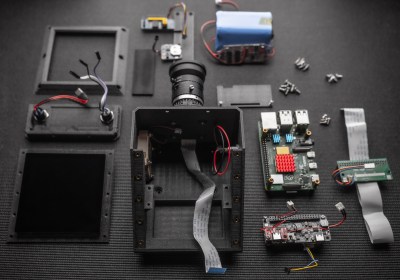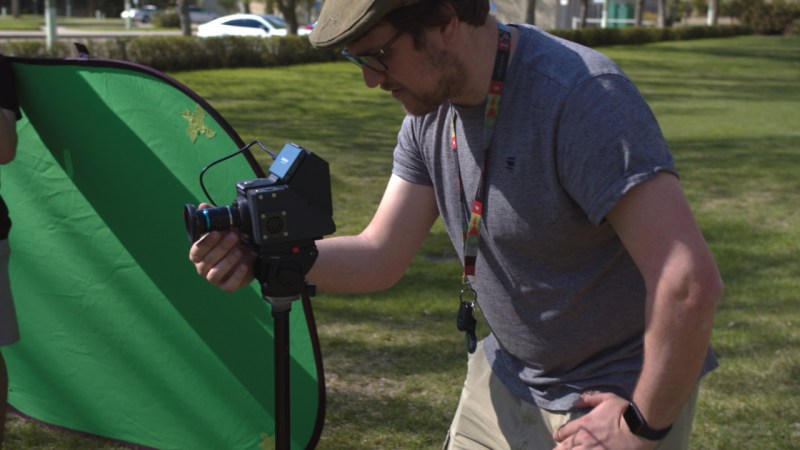Today, there’s open source options for pretty much anything mainstream, but that doesn’t mean there aren’t still some niches out there that could benefit from the libre treatment. The CinePi project is a perfect example — before today we didn’t even know that an open hardware and software cinema-quality camera was out there. But now that we do, we can’t wait to see what the community does with it.
 Inside the 3D printed enclosure of the CinePi, there’s a Raspberry Pi 4 with HQ camera module, a four-inch touch screen, a Zero2Go power supply with four 18650 cells, and a Notcua fan to keep it all cool. The design intentionally favors modules that are easy to source from the usual online sources. You’ll need to be handy with a soldering iron to follow along with the beautifully photographed assembly guide, but there’s nothing that needs to be custom fabricated to complete the build.
Inside the 3D printed enclosure of the CinePi, there’s a Raspberry Pi 4 with HQ camera module, a four-inch touch screen, a Zero2Go power supply with four 18650 cells, and a Notcua fan to keep it all cool. The design intentionally favors modules that are easy to source from the usual online sources. You’ll need to be handy with a soldering iron to follow along with the beautifully photographed assembly guide, but there’s nothing that needs to be custom fabricated to complete the build.
The software was clearly developed with the user experience in mind, and in the video below, you can see how its touch interface makes it easy to change settings on the fly. While an amateur auteur might need to enlist the assistance of their geeky friend to build the CinePi, it doesn’t look like they’ll need them around to help operate it.
Of course, the big question with a project like this: what does the video actually look like? Well the technical answer is that, in terms of raw performance, the CinePi is able to capture 3840 x 2160 CinemaDNG video to an external device such as a NVME SSD or a CFExpress Card at 25 frames per second. But what that actually looks like is going to depend on what kind of post-processing you do to it. For the more practical answer, check out the short film TIMEKEEPER which was shot partially on a CinePi.
If this all looks a bit high-tech for your liking, don’t worry. You could always 3D print yourself a 35 mm movie camera instead.















It would be useful to know to which footage “partially” applies. It looks to be an interesting project, but neither video clip reveals enough useful information to help decide whether it’s worth the effort to pursue. Hard to know if the camera is really “cine-quality.’
Here’s some back yard test footage from my compact CinePi build
CinePi Raspberry Pi Cinema Camera test footage
https://youtu.be/gTRtsl5JHW0
It’s not. Every Pi camera thus far has sucked ass, and this one is no exception. As a comment there says, look at the noise in the shadows on the left starting 45 seconds in. It’s junk.
Why are camera modules so crappy, when smartphones even at the budget level have no trouble with fairly high quality video? Is it just all in the post processing? Even then, that wouldn’t explain why action cams seem to have trouble keeping up with phones, and why most webcams aren’t great.
Because
– high end phones cost >1k of which a substantial amount goes on the camera, which is purchased in huge discount volumes
– phone manufacturers put huge amounts of work into getting the best cameras and photo systems
– a crap-ton of post processing. Sometimes too much, as when Samsung superimposed moons into fuzzy white circles.
The various camera modules for a Pi contain the exact same sensors that will be in many device including no doubt some phones – not that many sensor manufacturers, and they don’t make that many different sensors each. The thing that makes a smartphone sometimes seem better is how very much post process cheating they do on the image capture to make it look more ‘perfect’, along with these days having 3 or 4 separate camera at different focal length, sensitive into the IR for better low light performance etc to stick together and make up for the fact the lens will always suck on such small camera, as for the most part so do the sensors – Most smartphones don’t actually have the space with the quest for thinness to put a really good sensor or lens even behind the camera bump that has become so common in recent phones. Optically they just can’t compete even with the relatively low performance of a Pi HQ cam compared to a half-frame or full-frame mirrorless/DSLR, though in idiot proofing the fakery of a phone can help – you don’t need to understand anything about focal lengths, apature, ISO to get an image that looks ‘nice’ on a phone.
The only thing some phones can do the Pi can’t is ‘slow-mo’ video really – as while the Pi4 at least can’t drive a camera faster than 30fps at 1080p (or 90fps for 1080×720) IIRC for lack of CSI lane the quality of a well set up image with the decent camera and lens combo captured at 1080p will be higher than the reportedly higher resolution the phone may claim – real genuine image capture vs post processed to look like a deliberate image at all stuff.
so , you look at youtube compression and attribute it to the camera module? I actually build a copy of the camera, and the noise seen in the clip is not from the camera, but from post processing and youtube compression. the IMX477 is actually extremely low noise, and by recording in 12bit cinemaDNG , retains all the information needed for good post processing. I want to see ANY cellphone on the market that doesn’t do some shit post processing or Ai algorithm to clean up the image, making it look horribly overdrawn and sharpened when you try to look closer. Seriously, idiotic comment.
Yea I also used a canon film LUT in Davinci Resolve that added plenty of grain. Hackaday comments are worse than YouTube!
Does this look like junk to you?
https://youtu.be/uLXO96HZ7ik
25 frames a second – oh so close.
Standard movie frame rate is 24 FPS, so this is exactly where they want to be. Of course, if you needed higher framerate, you could lower the resolution.
I’m a plebe and know it’s 24 fps. The only problem with the internet is figuring if the OP is stupid or wants a response. I think both and they were successful.
Hmm, in my world everything we do is 30fps. Maybe we live in different worlds.
I believe 24fps is a, not the only, standard. It might be linked to mains electrical frequency, 60Hz in the US and 50 everywhere else.
It is directly linked to that. Bravo!
Film Standard was always 24fps.
Television / Video is a different story, half frames etc.
> “before today we didn’t even know that an open hardware and software cinema-quality camera was out there”
There WAS the Axiom from Apertus, https://www.apertus.org/axiom-beta but it seemed to have died in 2018. I don’t know if there is anything to salvage from a project ‘dormant’ for 5 years, but I guess you can look if there are some lessons to be learned
While there does seem to be a lack of updates on the axiom site, some of the related github repos do appear to have recent activity: https://github.com/apertus-open-source-cinema/dng-rs (Aug 2023) and https://github.com/apertus-open-source-cinema/axiom-firmware (Apr 2022), for instance.
Perhaps this project isn’t entirely dead yet? One can hope.
they have a youtube channel that updated early this year